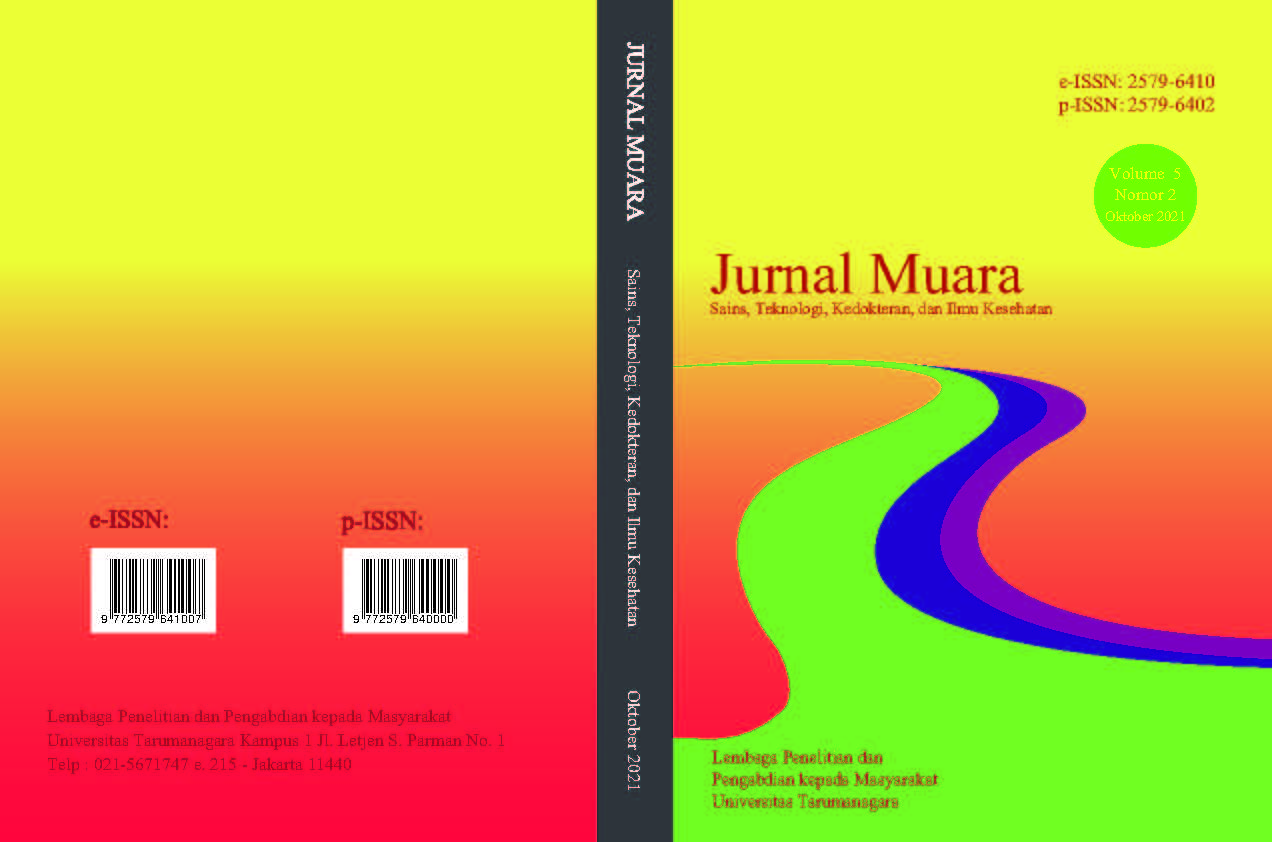KESESUAIAN KOLESTEROL LDL HASIL PERHITUNGAN SEJUMLAH FORMULA DENGAN KOLESTEROL LDL DIREK METODE ENZIMATIK
Main Article Content
Abstract
Increased cholesterol levels are the main cause of coronary heart disease. The results of examining LDL must be precise and accurate, but direct LDL examination (LDL-Direct) is quite expensive to do in a place with limited facilities so various experiments are carried out to get LDL formula (LDL-Cal) that is appropriate than formula commonly used, Friedewald formula. The aimed of this study was to determine the correlation between LDL cholesterol from calculation a number formulas with direct LDL cholesterol in order to obtain the best formula to be applied in laboratory of Lubuk Sikaping Hospital. This research was conducted on 75 patients who did lipid profile examination in laboratory of Lubuk Sikaping Hospital, who meet the inclusion criteria. Examination of total cholesterol, HDL, LDL and triglycerides were carried out by enzymatic methods on clinical chemistry analyzer. LDL cholesterol also calculated by several formulas namely Friedelwald formula (TC- (TG/5) -HDL), Chen formula (90% nonHDLC-10% TG), Anandaraja formula (0.9 TC- (0.9 TG/5) -28), Puavilai formula (TC-HDLC-TG/6), Vujovic formula (TC-HDLC-TG/3), and Cordova formula (3/4 (TC-HDLC.) Bland & Altman plot was used to compare the calculated LDL cholesterol level of each formula with the direct LDL. The mean LDL levels were 136.41 (35.92); 116.64 (32.72); 117.03 (30.83); 121.95 (32.79); 121.83 (33.23); 96.84 (32.47); 109.97 (28.24) for Direct, Friedelwald, Chen, Anandaraja, Puavilai, Vujovic, and Cordova respectively. Based on the Bland & Altman Plot, the calculation of LDL cholesterol from the Chen formula has the best compatibility with LDL-Direk with the mean difference of 19.3867 ± 19.0489 mg / dl at triglyceride levels <400 mg / dl, so it can be applied at RSUD Lubuk Sikaping with limited facilities.
Keywords: LDL Cholesterol; LDL-Direct; LDL-Cal
Abstrak
Peningkatan kadar kolesterol merupakan penyebab utama penyakit jantung koroner. Hasil pemeriksaan kadar LDL serum harus tepat dan akurat, namun pemeriksaan kadar LDL secara langsung (LDL-Direk) cukup mahal untuk dilakukan di tempat dengan fasilitas terbatas sehingga dilakukan berbagai percobaan untuk mendapatkan formula perhitungan LDL (LDL-Cal) yang lebih tepat dibandingkan formula yang telah umum digunakan yaitu formula Friedewald. Penelitian ini bertujuan untuk mengetahui kesesuaian antara kolesterol LDL hasil perhitungan sejumlah formula dengan kolesterol LDL direk sehingga diperoleh formula perhitungan terbaik untuk dapat diterapkan di laboratorium RSUD Lubuk Sikaping. Penelitian ini dilakukan terhadap 75 orang pasien yang melakukan pemeriksaan profil lipid lengkap ke Laboratorium RSUD Lubuk Sikaping. yang memenuhi kriteria inklusi. Pemeriksaan kolesterol total, HDL, LDL dan trigliserida dilakukan dengan metode enzimatik pada alat kimia klinik otomatis. Untuk kolesterol LDL juga dihitung dengan beberapa rumus yaitu formula Friedelwald (TC-(TG/5)-HDL). formula Chen (90%nonHDLC-10%TG), formula Anandaraja (0.9 TC- (0.9 TG/5)-28), formula Puavilai (TC-HDLC-TG/6), formula Vujovic (TC-HDLC-TG/3), dan formula Cordova (3/4 (TC-HDLC). Bland & Altman plot digunakan untuk membandingkan antara kadar kolesterol LDL hasil hitung masing-masing formula dengan LDL direk. Rerata kadar LDL (mg/dl) berturut-turut adalah 136,41 (35,92); 116,64 (32,72); 117,03 (30,83); 121,95 (32,79); 121,83 (33,23); 96,84 (32,47); 109,97 (28,24) untuk LDL-Direk, Friedelwald, Chen, Anandaraja, Puavilai, Vujovic, dan Cordova. Berdasarkan Bland & Altman Plot, perhitungan kolesterol LDL Formula Chen memiliki kesesuaian paling baik dengan LDL-Direk dengan selisih rerata 19,3867 ± 19,0489 mg/dl pada kadar trigliserida < 400 mg/dl, sehingga dapat diterapkan di RSUD Lubuk Sikaping dengan fasilitas yang terbatas.
Article Details
This work is licensed under a Jurnal Muara Sains, Teknologi, Kedokteran dan Ilmu Kesehatan Creative Commons Attribution-ShareAlike 4.0 International License.
Authors transfer copyright or assign exclusive rights to the publisher (including commercial rights)
References
Cholesterol, N., & Program, E. (n.d.). (2001). Third Report of the National Cholesterol Education Program (NCEP) Expert Panel on The National Cholesterol Education Program Expert Panel on Detection, Evaluation, and Treatment of High Blood Cholesterol in Adults (Adult Treatment Panel III). JAMA, 285: 2486-2497.
Dansethakul, P., Thapanathamchai, L., Saichanma, S., Worachartcheewan, A., & Pidetcha, P. (2015). Determining a new formula for calculating low-density lipoprotein cholesterol: Data mining approach. EXCLI Journal, 14, 478–483.
Fawwad, A., Sabir, R., Riaz, M., & Moin, H. (2016). Measured versus calculated LDL-cholesterol in subjects with type 2 diabetes. Pakistan Journal of Medical Sciences, 32(4), 955–960.
Karkhaneh, A., Bagherieh, M., Sadeghi, S., & Kheirollahi, A. (2019). Evaluation of eight formulas for LDL-C estimation in Iranian subjects with different metabolic health statuses. Lipids in Health and Disease, 18(1), 1–11.
Krishnaveni, P., & Gowda, V. M. N. (2015). Assessing the validity of friedewald’s formula and anandraja’s formula for serum LDL-cholesterol calculation. Journal of Clinical and Diagnostic Research, 9(12), BC01–BC04.
Martin, S. S., Blaha, M. J., Elshazly, M. B., Brinton, E. A., Toth, P. P., McEvoy, J. W., et al. (2013). Friedewald-estimated versus directly measured low-density lipoprotein cholesterol and treatment implications. Journal of the American College of Cardiology, 62(8), 732–739.
Martins, J., Olorunju, S. A. S., Murray, L. M., & Pillay, T. S. (2015). Comparison of equations for the calculation of LDL-cholesterol in hospitalized patients. Clinica Chimica Acta, 444, 137–142.
Razi, F., Forouzanfar, K., Bandarian, F., & Nasli-Esfahani, E. (2017). LDL-cholesterol measurement in diabetic type 2 patients: A comparison between direct assay and popular equations. Journal of Diabetes and Metabolic Disorders, 16(1), 1–5.
Rim, J. H., Lee, Y. H., Lee, M. H., Kim, H. Y., Choi, J., Lee, B. W., et al. (2016). Comparison and Validation of 10 Equations Including a Novel Method for Estimation of LDL-cholesterol in a 168,212 Asian Population. Medicine (United States), 95(14), 1–8.



